|
|
|---|---|
Edition 73 - September 2014 Published at Quepos, Canton of Aguirre, Province of Puntarenas, Costa Rica (© Copyright 2014 - All Rights Reserved) |
A narrative version of the Golden Gringo Chronicles is now available as a trilogy of E-books in formats compatible with virtually all electronic platforms. Click on Part Number above for E-book sample downloads or click the price above on the right for purchase. (The best price is on Part 1; it's FREE)
The story of the Golden Gringo Chronicles is also available as a hard copy novel of 192 pages available through Amazon and all major online retailers. ($9.95) Amazon link: GGC, the Book. (Kindle Edition available) Follow GG through the first six years of his odyssey in making the decision to retire in Costa Rica, overcoming the trials and tribulations of moving and obtaining residency there and the fun and experience of actually living in Ticoland. Ride along with the Golden Gringo as he learns about the rich, varied culture of Costa Rica, the incredible bio diversity, the charming nature of the Costa Rican people and the ease with which a sometimes clueless ex-pat can assimilate into a small southwestern town on the Pacific coast. Whether you are already a Costa Rican resident, someone contemplating a move here or just a traveler who enjoys different cultures, you will find the Golden Gringo Chronicles interesting, entertaining and informative about Costa Rica. |
Broken News
(All the News That's Fit to Reprint)
Solis Levying Decrees and Raising Eyebrows
When you're captain of a freighter or warship your authority aboard is unquestionable. It doesn't always work that way when you're captain of a ship of state, particularly a democratic one. Our new president in Costa Rica, Luis Guillermo Solis, is finding that out.
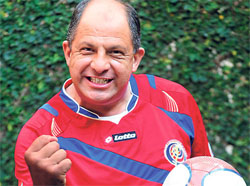 |
The Prez at World Cup Time |
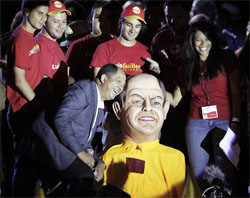 |
Billy Solis Denying He's Bringing Out a New Line of Prez Dolls |
Senor Solis entered his office enthused, promising eradication of corruption and a balanced budget and true to form he's been trying to rein in spending. He's put curbs on new government hiring, rental of new buildings, reduced spending on "nonessential" items by 20% and frozen salaries for administrative heads.
But lately he's been making moves that may not be his to make on his own, generating resentment among the branches of government and in some cases prompting law suits. It all started when Solis appointed an active Methodist Bishop as his Chief of Staff (see Catholics No, Methodists Yes) although the constitution prohibits clerics from these positions. He argued rather speciously that the constitution only prohibited Catholics (come on BIlly, even the Pope won't buy that one).
Next was the argument over the Mercado de Artesanía, an area near the Plaza de Democracíain San José that's been used as a tourist flea market for years. In 2009, former president Oscar Arias (two prezes ago) vetoed an assembly bill which would have allowed the vendors to stay, so, under pressure from the city of San Jose, they were to move. Now Solis decreed (he's good at these, with or without pen and telephone) that he "undid" the Arias veto so the artisans could stay. The judiciary is not too happy with this one. It was less than a week before lawmakers filed suit in court to undo the Solis undoing.
He next reversed the Chinchilla administration expansion of the new definition of what businesses are covered under the old sales tax law to cover tour operators. Although that was a good move for the tour businesses and tourists (shaves $2 off the price of admission at Manuel Antonio park, for example), the assembly was a bit miffed at not being consulted by either one of the prezes on this subject. By the end of August, the Dirección General de Tributación, who is responsible for levying the tax, redefined their interpretation to exclude public parks like Manuel Antonio but their version would still cover tour operators. The DGT will likely take this one to court to override the Presidential decree.
The next Solis decree involved limiting maximum retirement salaries to "10 times the base salary of the lowest paid salary in Costa Rica's public administration", whatever that means. I would guess the lowest paid employee is not too empathetic to retirees getting ten times the peon's current salary. This one is bound to evoke a law suit also, probably from the public employees union.
The Chronicles will keep their best Casa Presidential reporter (guess who that is) on this and report any further decrees and brouhahas as they occur.
¡Pura Vida!
Minimum Wage Adjustment Time
In Costa Rica, minimum wages are established by the government for over two hundred and fifty different categories of jobs. Press reports state that almost 80% of jobs are covered by minimum wage regulations, which basically means that the vast majority of people are paid at minimum wage.
The government establishes increases in the minimums twice per year, at the beginning of the year and mid-way through it. The government organ responsible for establishing the increases is the Ministerio de Trabajo (Ministry of Labor), a department of the Seguro Sociál (Social Security) but the recommendation for the increases comes from the Consejo Nacional de Salarios (National Council for Salaries) which in turn listens to employers through their Chamber associations and also to the unions and tries to arrive at a compromise. Needless to say this is a highly political exercise.
For this latest (semi-annual) adjustment, the CNS recommendation abandoned the single percent increase approach in favor of a sliding scale of 2.35 to 4.2% depending on the job (lower paying jobs got the higher percentage). That resulted in the the table below, which is a sampling of only 11 of the 250 jobs covered but includes a range from the lowest (general farm worker) to the highest (journalist) posted.
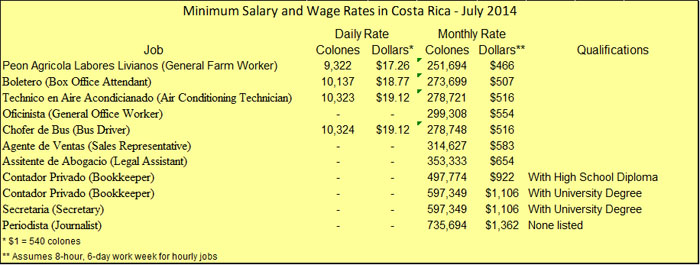 |
In addition to the wages above, a worker receives an annual bonus called an aguinaldo in December that amounts to one extra month's pay. In addition, employers must pay 23% of the wages and salary amount to the Seguro Social to fund retirement benefits as well as pay the cost of the Caja or national health plan. Employees also pay 9% into the SS system for a total of 32% between employer and employee. There are significant premiums for late shifts, holidays and weekends but the basic work week is 6 days at 8 hours or 48 hours per week. That means the farm worker is getting about $2.24 per hour, the legal assistant about $3.14 per hour and the secretary with a college degree about $5.32.
Another source of income for a worker is the liquidation settlement. Basically, the government requires the company to pay a severance of one month per year worked when a company terminates it's operations. A sale to another corporation is considered a termination by the government. One technique used by many companies to avoid accumulation of this settlement is to liquidate all employees at least once per year and then rehire them. A friend of mine who recently sold a business and who had not been liquidating regularly on the dozen employees he had, employees who probably accounted for total monthly wages of $6,000 to $9,000 per month, was faced with an extra bill of $60,000 on liquidation.
GG is not new to the fact that many Costa Ricans try to exist on $500-600 per month in an economy where food costs are almost equivalent to the U.S., auto purchase costs are at a very significant premium to the U.S. due to import taxes and gasoline runs at a 50% premium over the U.S. (recently $5.52 versus $3.68 per gallon). It's not hard to understand why busses are the preferred (and necessary) method of travel by many Ticos in Ticoland.
The other thing that struck GG about the data was how well a journalist does despite there being no requirement to have a diploma or degree for the job. They earn a minimum of an 80% premium over a medical technician for example. And the journalist gets a whopping 164% premium over the bus driver. Dude, how did they figure those out? Personally I would have given a little higher ranking to the med tech and the bus driver, people with whom I put my life in their hands on a daily basis; I have rarely had my health put in jeopardy by a poorly written article.
Vehicle Death Rate Up
The Policía de Tránsito (kind of like the Highway Patrol) reports that vehicle deaths were up by 33 in a total of 189 for the first half of this year. Of this total, some 68 or 36% were the result of motorcycle accidents. The figures might be a little light as a quirk in the reporting system in Costa Rica only counts those dead at the scene and not those that die later in the hospital (don't ask). The 189 figure converts to an annual death rate of about 8.4 per 100,000 population.
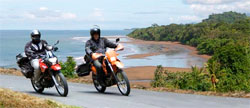 |
Ride Carefully Amigos |
Comparable figures in the U.S. (as best GG can interpret them) are that 5,446 died in motorcycle accidents in a total vehicular death count of 33,580 or about 16% of the total. The overall U.S. death rate from vehicles converts to about 10.7 per 100,000 population. It's interesting to note that the vehicle death rate in the U.S. has declined by 38% since 1970. It would also be interesting to compare rates to the number of registered vehicles (motorcycles) in both countries but GG could not find reliable data for that number in Costa Rica. (GG suspects the data for Costa Rica would be less favorable in such a comparison because the number of vehicles per population should be significantly less due to the difference in affluence between the two countries).
The motorcycle risk was brought home to GG recently when he asked about a certain employee at a local supermarket who had been friendly and helpful to him for some time but whom he hadn't seen for several days. "Oh, senor, he was killed in a motorcycle accident with a bus last weekend." Twenty-three years old, just married. Sad.
¡Solo Bueno!
Rumble Talk
(Shaky Happenings On or About the Pacific Rim)
Tropical Bird of the Month |
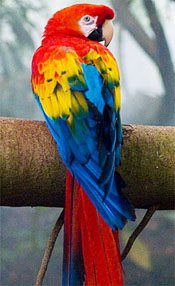 |
Scarlet Macaw |
GG had started some days ago to write this "The most significant happening along the "Rim" this past month was not in Costa Rica but in Ecuador. A 5.1 Richter earthquake is usually not considered a significant event but this one killed two people, injured eight and three are still missing."
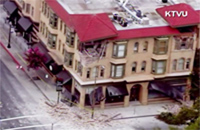 |
Napa Damage |
Then on August 24 at 4:20 AM in the morning, the 6.0 earthquake hit the Napa area in California. Lots of shaking and dozens of injuries were reported and early estimates were that over $1 billion in property damage has been incurred.
Most people know that the Richter number measures the strength of a quake (energy release) but many do not know that the scale is logarithmic, that is, a 7.0 quake releases 10 times the energy of a 6.0 and a 6.0 ten times that of a 5.0. But what determines the potential damage to life and property depends on other factors as well (see: Richter Scale Explained: Edition 20 - Earthquake Chart).
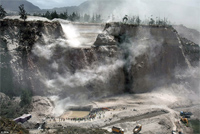 |
Quarry Near Quito, Ecuador |
In Ecuador the tremor occurred only 14 miles northeast of the capital Quito. The deaths and missing people happened at a quarry in that area where a very high wall collapsed (see photo right). Another factor affecting the outcome was the shallow depth of the tremor - only about 8 kilometers or less than 5 miles deep, relatively shallow. Haiti was 13 km or only 8 miles deep; the Napa tremor was only 11 km or 7 miles deep, the 2012 Nicoya, Costa Rica terremoto, 7.6R, was 41 km or 25 miles deep).
Buildings in downtown Quito (1.6 million people) wavered and shook and many people ran into the streets to get away from them. The tremor generated so much dust from the quarry that the main airport serving Quito was closed for a number of hours.
Not to be outdone by the Napa event, a 6.9 quake registered in Peru 13 hours later. The good news is that it was 101 km or 65 miles deep, which helped reduce its effect.
The Rim this month has been quite active.
Late Bulletin: GG was visiting San José the weekend of August 29-30-31 and was comfortably snuggled into his bed on the 6th floor of a hotel in the center of town when, at 4:01 AM on Sunday the 31st, I was awakened by the bed shaking to and for for about 10 seconds. I got up and went down to the desk where I encountered another guest already talking about it. A few hours later the USGS posted a quake centered about 15 miles west/southwest of San Isidro (see USGS link below) with a magnitude 4.9 (University of Costa Rica Lab later sized it at 5.2) and 35 km (21 miles) deep (moderate depth). That was a moderate strength, moderate depth, moderate distance (73 km or 44 miles as the hummingbird flitters) tremblor but enough to rattle one into consciousness.
Articles of interest regarding past tremors in Costa Rica are here:
Richter Scale Explained: Edition 20 - Earthquake Chart
The 7.6 Earthquake, Surviving: Edition 50 - Terremoto Terror
The 7.6 Earthquake, Aftermath: Edition 51 - More on the Big One
| Check Out Recent Earthquakes Around the World Posted by the U.S. Geodetic Survey: Today's Quakes |
|---|
Isla de Coiba
(The Devil Is In the Details)
Some miscreant heads of countries throughout history have often used the most beautiful, remote places on our planet for horrible purposes.
Probably the most famous example of this is Isle du Diable, the French Devil's Island located 10 miles off French Guiana on the northeastern coast of South America to which France sent its worst criminals for over one hundred years to be treated in the worst way. This legendary island and prison was the inspiration for the 1973 film Papillon (1973 - Columbia Pictures, starring Steve McQueen, Duston Hoffman and Victor Jory).
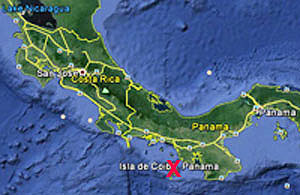 |
So it was in the same way with Isla de Coiba, an island 18 miles off the Pacific Coast of Panama and only about 100 miles south-southeast, as the macaw flies, from the Costa Rican border with Panama. The 18 mile long island is a virtual paradise with white sand beaches flanked by tall palms and offering warm, crystal clear waters.
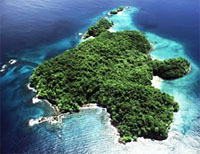 |
Aerial View Isla de Coiba |
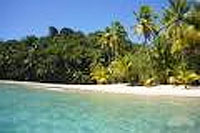 |
A Beach on Isla de Coiba |
But that's where it ends. The 18 mile swim to the mainland is treacherous to begin with but the presence of a great number of crocodiles and sharks in the waters around the island make it an easy place to keep prisoners without the need for fences. It kind of makes Alcatraz look charming.
The island should have been a resort area but its remoteness and isolation made it valuable to dictators like Panama's General Manuel Antonio Noriega. Noriega was ousted in a U.S. invasion in 1989 and spent 20 years in a U.S. federal prison. The U.S. extradited Noriega to France in 2010 to face charges he laundered some $3 million in drug money, where he was convicted and handed a seven-year sentence. It appears he'll be available to the world once more in just a few years.
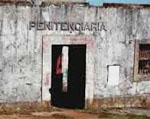 |
Entrance to the Coiba Penitentiary |
When he was in power, Noriega liked to use Isla de Coiba to house, mistreat and torture anyone he didn't like. That included his political enemies, some 74 military personnel caught in an attempted coup and many of the worst criminals in Panama such as mass murderers. The mass murderers and brutal military did a lot to help Noriega by making sure many of the political prisoners were never seen again. There is a story that during the coup, when the U.S. troops landed on the island without firing a shot, it took a dozen U.S. troops to subdue just one of the worst mass murderers.
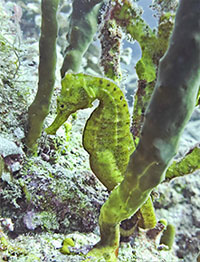 |
Photo of a Seahorse Taken Near Isla de Coiba |
The population of the penal colony was about 900 when the U.S. landed. Noriega also used his captives there as slaves forcing them to work twelve hour days growing crops which he sold at a profit on the mainland in businesses set up by the general's cronies in the Panama Defense Forces. The businesses also gave him an outlet for money laundering, a resource he needed to underwrite his other business which was as a drug cartel onto himself.
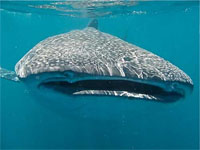 |
Whale Shark |
Isla de Coiba today is a national park of Panama comprising not only the main island but 37 other smaller ones for a total area, including the waters surrounding the islands, of 480,000 acres. The park offers some of the best snorkeling, diving and fishing in the world in incredibly clear waters.
Here you can find some of the most interesting creatures like small seahorses from one to twelve inches in length and whale sharks that can grow up to 40 feet in length and weigh up to 47,000 lbs or over 21 tons. Both species are relatively common in the waters around Isla de Coiba.
Snorkeling sounds like a much better use of these islands and waters than a prison camp. But watch out for the crocs and sharks amigos.
¡Pura Vida!
Primate Peculiarities
(Monkey Business in Costa Rica)
There have been a number of articles in the Chronicles over the last six years on a wide variety of Costa Rican wildlife including Bats, Birds, Bugs, Butterflies, Crocodiles, Frogs, Killer Fish, Leafcutter Ants, Lizards, Oxen, Sloths, Tapirs, Wild Cats and Woodpeckers. But somehow we missed, until now, one of our best friends in the jungle, the monkeys. Forgive me, our furry friends.
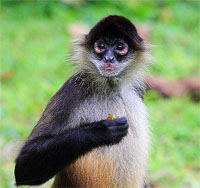 |
Spider Monkey |
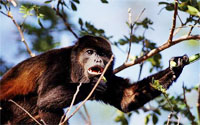 |
Congo or Howler Monkey |
 |
A Tiny Marmoset |
 |
Squirrel or "Titi" Monkey |
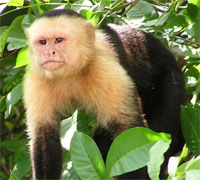 |
Capuchin or White-Face |
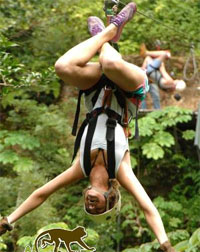 |
Unidentified Monkey Specie |
There are 264 species of monkeys in the world and the four that are indigenous to Costa Rica are shown in the photos left and right. The smallest is the Squirrel or Titi monkey. These little characters are common in the Quepos-Manuel Antonio area and are easily identified by their orange-brownish coat.
One time GG was sitting in a restaurant in Manuel Antonio when a Titi appeared, entered the restaurant and stood upright on a serving bar only a few feet from us with his hands on his hips. The look he gave was sort of like "What are you guys doing in my rain forest?" (Of course, it's possible that look was more like "Hey, what's for lunch amigo?") I moved my chair a little and he scurried off.
Which brings us to the point some tourists overlook, namely, do not feed the monkeys - anything. There are several reasons not least among them are 1) diseases can pass both ways through touch, 2) it creates a dependency that can disrupt their lives and 3) they are too often fed the wrong food for their good health.
The next size monkey up from the Titi is the Capuchin or White-Faced monkey. They are thought to be the most intelligent of monkeys. Says one source about the Capuchins: "They have the ability to use tools, learn new skills and show various signs of self-awareness." And GG will testify to the White-Faces being the most mischievous. Once you've had your backpack opened by one (they do zippers well) and have it ransacked you'll know what I mean. This is common at the beach in Manuel Antonio park.
Contrary to legend, bananas are not our monkeys favorite staple. Monkeys, particularly Capuchins, are true omnivores, that is they eat fruits (figs, mangos and others), flowers, young leaves, seeds of certain plants, bromeliads and some insects. Bromeliads serve not only as a food source but trap water the monkeys can take advantage of. Pregnant females will turn to small insects, lizards and even bird eggs for the protein to support the development of their future offspring.
The other two monkeys in Costa Rica are the Spider and the Howler or Congo. The Howler makes its presence known by issuing a growling howl that reverberates across the jungle, especially early in the morning (to the aggravation of some humans). Its not easily seen as it prefers to hang out high in the canopy but occasionally one can spy them at lower levels. The Spider is only found in the Southwest Pacific coast of Costa Rica (and Panama) in the Osa peninsula and particularly in the Corcovado National Park. It gets its name from its unusually long arms, legs and tail.
Marmosets are another form of monkey but are tiny in comparison (see picture upper right) and not indigenous to Costa Rica. They prefer the dry forests of Brazil and Africa. Marmosets are very small and typically weigh only 250 grams or about 9 ounces. That's compared to a Titi at approximately 800 grams (1.75 lbs), a White-Face at approximately 3 kilos (6-1/2 lbs), a Howler at approximately 8-1/2 kilos (19 lbs) and a Spider that averages 11 kg (24 lbs).
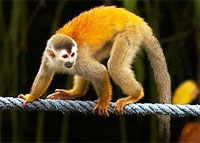 |
Titi on Monkey Bridge (Photo Courtesy D. Morgan |
Monkeys are not apes. Apes are much larger and are particularly distinguished by the absence of a tail, which most monkeys have. Apes, like humans, can also swing by their arms through the jungle but monkeys don't do this because the physiology of the structure of their shoulders will not support it. Monkeys walk or crawl to another position although they will often jump.
And that's our monkey business for this month.
¡Pura Vida!
Centenarian Capers
(Living Beyond the 100 Mark)
Life expectancy isn't what it used to be. It's much better.
 |
First let's define the subtle but important difference between "longevity" and "life expectancy", two terms often (mistakenly) used as being interchangeable. Longevity is properly used to describe the number of years any person lives.
Life expectancy is the average life span of a group of people, a segment of the population or a population as a whole. Life expectancy can be calculated and reported at any age, life expectancy at birth being the most common way of expressing it. Life expectancy at birth for the United States and Costa Rica are currently the same number of years, 79.8 years.
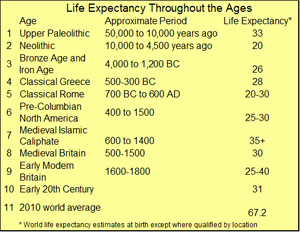 |
The table to the left gives approximate values (best data available to researchers) showing how life expectancy has changed over time. For most of the last 50,000 years, life expectancy at birth hovered at the 20-30 years level or slightly above. Then, in the last century, life expectancy at birth has more than doubled!
The reasons are two-fold: 1) infant mortality rates have plummeted as more and more babies are born in better controlled atmospheres, i.e., hospitals and 2) there has been a dramatic decrease in deaths resulting from infections due to improved medicines, especially antibiotics (despite the heavy casualties from warfare in the 20th century).
But one must keep in mind that these numbers are averages of all people's lives including the high infant mortality rates. For example, even in the paleolithic period, if you survived to age 15, your life expectancy then increased into the fifties. In classical Rome if you lived to the age of 10, your life expectancy then increased to 45-47 and in medieval Britain, if you made it to age 21, you could expect another 43 years putting you into the mid-sixties. In the U.S., life expectancy at birth is currently better than 79 but if you make it to 35, life expectancy increases to 80 and if you make it to 65, life expectancy increases to 83. Even those that make it to 100 have a statistical life expectancy of another two years.
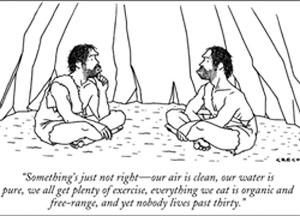 |
Puzzled Cave Men |
Which brings us to the fastest growing age group, those over 90 and specifically those over 100, the centenarians. (Those that pass 110 are called "supercentenarians") When GG was selling life insurance in the 90's (not my favorite job) information came across my desk that centenarians were the fastest growing age group in the U.S., and they still are.
The following was reported after the 2010 census: "The nation's 90-and-older population nearly tripled over the past three decades, reaching 1.9 million in 2010, according to a report released today by the U.S. Census Bureau and supported by the National Institute on Aging. Over the next four decades, this population is projected to more than quadruple."
So who are these 100+ dudes? The top 10 living supercentenarians; i.e., those with 110+ years of age or more, as we go to press are shown in the table below. Of course, the list needs to be and is updated virtually daily by Guinness. The data below is as of July 24, 2014.
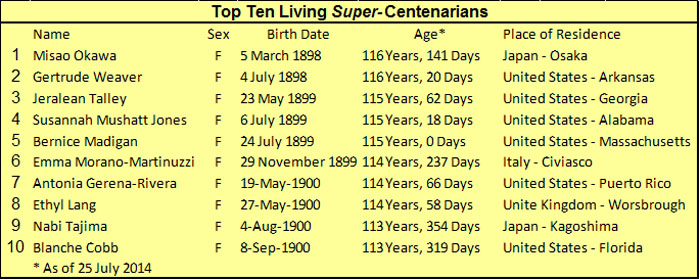 |
There are several interesting things about this data: a) they're all female; b) six out of the ten are from the U.S.; c) of the six from the U.S., five are from the South; d) one of them carries the same birth date as my father - 6 July 1899 (he died in 1976 at the age of 77). You know you're getting old when you realize your dad would have been 115 years old today.
.jpg) |
Chepito With Cédula |
Costa Rica has at least one rather famous supercentenarian, a fellow named José Delgado Corrales who carries a cédula with a birth date of March 13, 1900. That makes him 114 years, 137 days old and would put him in the 7th position in the table above. Probably the reason he isn't on that table is that his case has never been reviewed by Guinness and therefore is not verified. If it were, he'd still not be listed in another important list, the 100 oldest people living or dead as he'd miss that group by 236 days.
Senor Delgado lives in a retirement home in the Central Valley (Santa Ana) and keeps the nuns who run the facility busy because he likes to escape and walk around the neighborhood without supervision. In the recent past, when he was younger, i.e., only 112, Chepito held his birthday party at TGIF Friday's in Escazu where he danced with numerous ladies. (to see Chepito cutting it up go here: Uncle Chepito).
 |
What produces centenarians?
A naturally healthy and inherited physical profile seems to be the biggest factor; there is nothing more important than starting out with good DNA. Other than the super-agreeable DNA structure that is prevalent among them, there appears not to be another single common factor that produces centenarians. Careful diets, often touted by health "experts", don't seem to be a major factor, although moderation seems to be a common practice among the centenarians, particularly after the age of 70 (no smoking, very moderate alcohol).
In their own way most of the centenarians and supercentenarians encourage the exercise of what psychologists call "neurobics", keeping their mind active in various ways (like writing a monthly newsletter).
Here are some quotes from the 100+ people:

It ain't over until it's over amigos.
¡Pura Vida!
|
“When you travel, remember that a foreign country is not designed to make you comfortable. It is designed to make its own people comfortable.” – Clifton Fadiman |
What's-in-a-Word
Ramón
Ramón is a common name throughout the Latino world, and there are numerous towns named San Ramón, sorta like Washington or Franklin in the States.
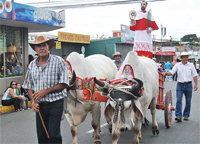 |
Festival in San Ramón de Alejuela |
San Ramón is a saint well venerated in Costa Rica. A town in the Central Valley, San Ramón de Alejuela, has a festival this time of year (GG has commented before that there seems to be a festival of some kind here every week in Costa Rica). This year the parade included some 240 teams of oxen with carts (dude, that's almost 500 oxen). The saint being venerated in this Alejuela town is San Ramón Nonato, and he has two interesting names.
The best translation of Ramón to English is protected by God and the Nonato part means never having been born. San Ramón fit that last part well as he was delivered by cesarean section when his mother died.
As a priest he was sent to Africa to ransom Christians being held by Muslims (whoa, sound familiar?). He exchanged himself for hostages when his money ran out. Catholic Church history reports Ramón was tortured, including "having his lips punctured to accommodate a lock so he would not discuss Catholicism.".
That would end discussion in most places.
ROMEO Corner
(Retired Old Men Eating Out)
Gondola Restaurant, Manuel Antonio
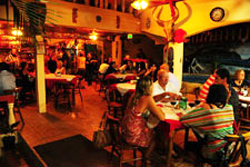 |
Location: Hotel Tres Banderas, from the MA futbol field go down the hill towards Quepos 150 meters, on the right.
Hours: 3 PM to 10 PM, Monday thru Sunday
Parking: Ample, at the restaurant
Contact: Tel.: 2777-1521; Email: silcrc@hotmail.com;
Website: http://www.gondolagourmet.com/
Reviewing ROMEOS: Anita M., Bob N.
To Review Our Rating System and Procedure, go here: R.O.M.E.O. Rating System
One tends to snicker at signs that include the words "Gourmet Restaurant" under the restaurant's name particularly if you're not in New York or Paris. So it was with GG until he sampled this place.
Accessing the restaurant is easy if you have a car but a bit, if you're walking, it's a bit of a hike up the hill from the bus stop and then a steep entrance alley (we old dudes need to complain about something).
The main dining room is not large, probably seats 35 or less. It is pleasantly lighted, strong enough to easily read the menu yet subdued enough to give a warm atmosphere. There are some casual decorations scattered about the walls including some pictures that seem to be from a fishing tournament. The tables are the type of plain, hard (on my back) wood common in these parts but they were covered with double table cloths for dinner. Four sloths for atmosphere.
We came to learn that the chef here is a lady of Italian origin whose reputation preceded her. Her name is Sylvana and she previously had at least one restaurant in Quepos. The kitchen team is a family affair with the executive chef being Sylvana and supported by her son and friends.
GG selected an appetizer consisting of sauteed spinach and accompanied by some mushrooms in a cream sauce. The lightly spiced flavors were outstanding. My dining partner had the eggplant rolls that were stuffed with mozzarella and basil - she shared one with me - excellent. For main courses, GG had the tenderloin slices, cooked "au point" (medium rare) as the French would say, served over a bed of watercress, lightly covered with a clear caper sauce and served with small roasted potatoes dusted with basil. My dining partner had the meat stuffed ravioli with a walnut sauce sprinkled with small slivers of hard parmesan. Both dishes were outstanding. GG added a grilled pineapple slice with a dollop of walnut flavored ice cream for dessert artfully served with drizzled raspberry. We give the Gondola five sloths for food quality. |
 |
|---|---|
$$$$1/2 |
|
Value Index = 111 |
Service was also outstanding, our waitress was attentive and helpful. The chef herself came out of the kitchen to make sure we were happy with the meal and we even had a brief conversation at our table with the hotel owner (Andy). We give the restaurant five sloths for service also and that gives an overall rating of five sloths for atmosphere, food quality and service.
The check for GG for the spinach appetizer, tenderloin and pineapple dessert plus one coke was about 22,000 colones or $40. My partner's bill came in a little less. That puts Gondola not at the top price level for Manuel Antonio but near it and we gave the restaurant 4-1/2 $ for a cost rating and 5/4.5 x 100 = 111 for a value index.
The ROMEO club can heartily recommend the Gondola at Tres Banderas for quality food with an interesting Italian flare.
don Beto de Quepos,
El Gringo Dorado Pura Vida! |
Be pithy but kind. I'm sensitive. |
|---|














